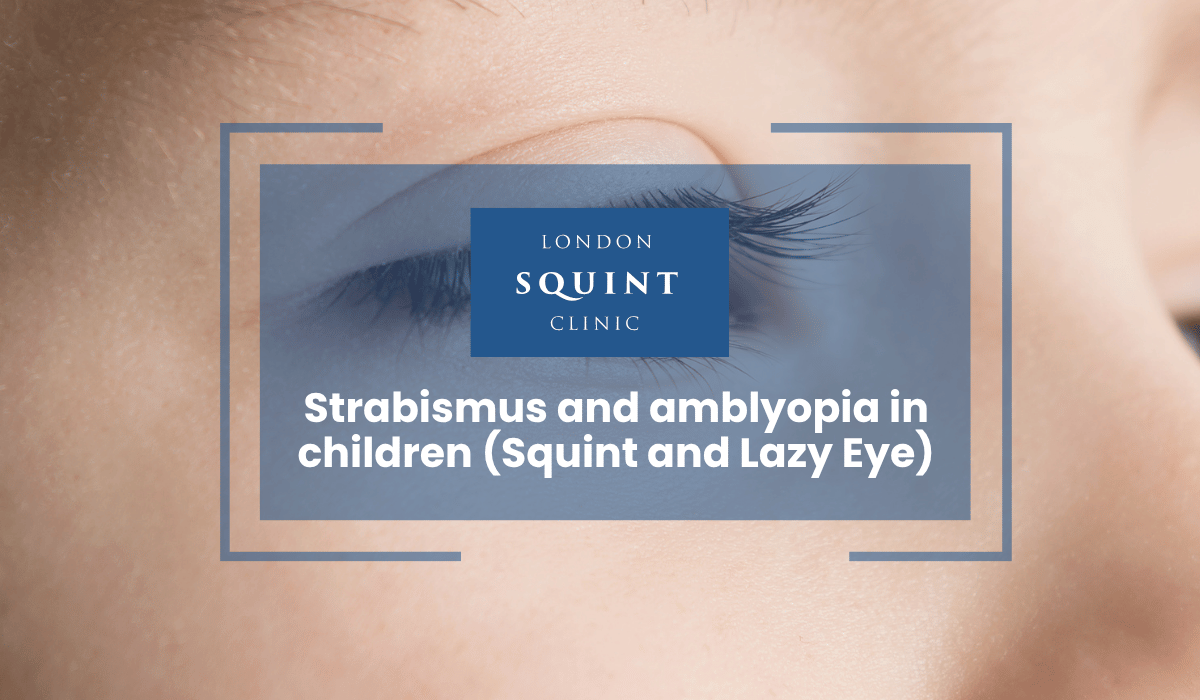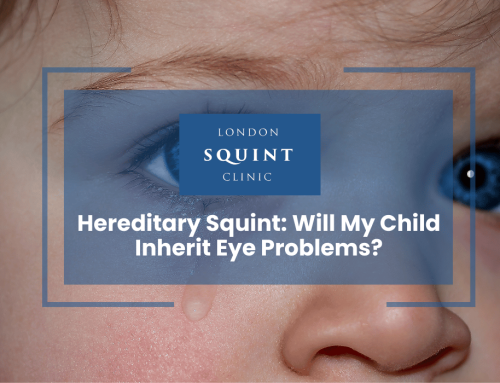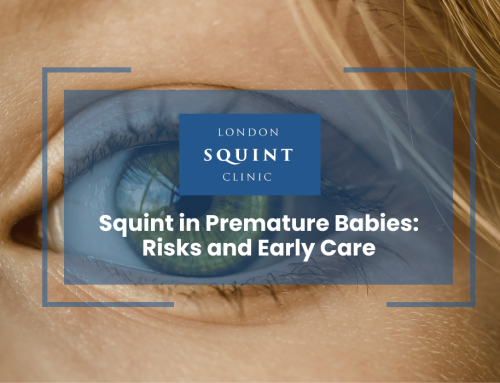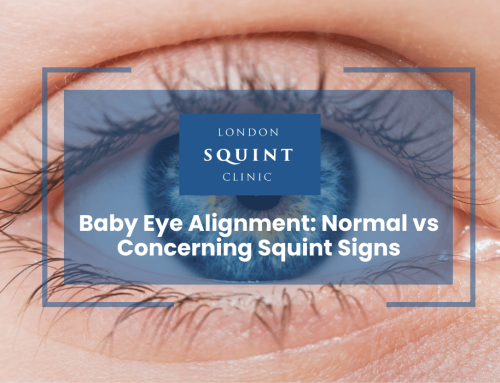Strabismus and amblyopia in children (squint and lazy eye)
Strabismus and Amblyopia in Children
- Strabismus (squint) is a physical eye misalignment, while amblyopia (lazy eye) is a functional vision problem; they often occur together as untreated strabismus can lead to amblyopia.
- Common causes of childhood squint include refractive errors, muscle control issues, genetic factors, and occasionally serious underlying conditions.
- Early warning signs include asymmetrical light reflection in the eyes, unusual head positioning, poor depth perception, and intermittent eye turning, especially when tired.
- Treatment options include prescription glasses, eye patching therapy, vision exercises, and in some cases, surgery or Botox injections.
- Seek professional help for any eye misalignment in babies older than 3-4 months; don’t wait to see if children “grow out of it” as this can lead to permanent vision impairment.
- With early intervention, most children with strabismus achieve good functional and cosmetic outcomes, though some may require multiple treatments over time.
- Regular vision screening is essential for all children, especially those with developmental delays, premature birth history, or family history of eye conditions.
Table of Contents
- Understanding Strabismus and Amblyopia: Key Differences
- Common Causes of Sudden and Intermittent Squint in Children
- How to Identify Early Signs of Squint in Babies and Toddlers
- Is Lazy Eye the Same as a Squint? Explaining the Connection
- Effective Treatment Options for Childhood Squint and Amblyopia
- When to Seek Professional Help for Your Child’s Eye Alignment
- Long-term Outcomes: Can Childhood Strabismus Be Corrected?
Understanding Strabismus and Amblyopia: Key Differences
Strabismus (squint) and amblyopia (lazy eye) are two distinct yet often interconnected childhood eye conditions that can significantly impact visual development. Understanding the difference between these conditions is crucial for proper diagnosis and treatment.
Strabismus refers to a misalignment of the eyes where they point in different directions. One eye may turn inward (convergent squint or esotropia), outward (divergent squint or exotropia), upward, or downward. This misalignment can be constant or intermittent, appearing suddenly in some children. When a 1-year-old baby is squinting eyes or you notice a 3-year-old squinting eyes, this could indicate strabismus.
Amblyopia, commonly known as lazy eye, is a neurodevelopmental condition where vision in one eye fails to develop properly during early childhood. This results in reduced vision in the affected eye, even with the best corrective lenses. Unlike strabismus, amblyopia is not always visible from external appearance, making it harder to detect without professional examination.
The critical distinction is that strabismus is a physical misalignment, while amblyopia is a functional vision problem. However, they frequently occur together because prolonged eye misalignment can lead to the brain suppressing vision from the turned eye to avoid double vision, eventually causing amblyopia. Early detection in infants and toddlers, including a 9-month-old baby squinting eyes, is essential for successful treatment and preventing permanent vision loss.
Common Causes of Sudden and Intermittent Squint in Children
A sudden squint in a child can be alarming for parents. Several factors can contribute to the development of both sudden and intermittent squints in children, ranging from genetic predispositions to specific health conditions.
Refractive errors are among the most common causes. Significant uncorrected long-sightedness (hyperopia) can lead to accommodative esotropia, where the eyes turn inward during visual focusing. This type of squint may appear intermittently at first, particularly when a child is tired or concentrating on near objects.
Muscle control issues can also trigger strabismus. The six muscles controlling each eye must work in perfect coordination. Any weakness, injury, or neurological issue affecting these muscles can result in eye misalignment. In some cases, a viral illness or fever can temporarily affect eye muscle control, causing a sudden squint that may resolve as the child recovers.
Genetic factors play a significant role as well. Children with family members who have strabismus are at higher risk of developing the condition themselves. Certain genetic syndromes and conditions like Down syndrome are associated with higher rates of eye misalignment.
Less commonly, serious underlying conditions such as cranial nerve palsy, brain tumours, or increased intracranial pressure can cause a sudden onset squint. This is why any sudden squint in a child warrants prompt medical evaluation to rule out these possibilities.
Intermittent squints often have triggers such as fatigue, illness, or stress. Parents might notice their 3-year-old squinting eyes when tired or their 1-year-old baby squinting eyes when trying to focus on something interesting. These patterns provide valuable diagnostic information for eye specialists.
How to Identify Early Signs of Squint in Babies and Toddlers
Detecting a squint early in babies and toddlers is crucial for successful treatment and prevention of long-term vision problems. Parents and caregivers should be vigilant for several key indicators that might suggest eye misalignment.
One of the earliest signs is asymmetrical light reflection in the eyes. When light shines into properly aligned eyes, the reflection appears in the same position in both pupils. In a child with strabismus, these reflections appear in different positions. This can sometimes be noticed in photographs where one eye shows the “red-eye” effect and the other doesn’t.
Unusual head positioning is another important indicator. If you notice your 9-month-old baby squinting eyes and tilting their head consistently to one side when looking at objects, this could be an attempt to compensate for double vision or a misaligned visual field. Similarly, a 1-year-old baby squinting eyes and closing one eye when looking at things may be trying to eliminate confusing visual input from the misaligned eye.
Poor depth perception might manifest as clumsiness or difficulty with hand-eye coordination tasks appropriate for their age. A 3-year-old squinting eyes when reaching for objects or having trouble with simple puzzles could indicate vision problems related to eye alignment.
Intermittent eye turning is particularly common when children are tired or unwell. Parents might notice that their toddler’s eye drifts inward or outward when they’re fatigued, which can be an early sign of intermittent strabismus.
It’s important to note that some babies may appear to have crossed eyes due to a broad nasal bridge creating an optical illusion called pseudostrabismus. This typically resolves as facial features develop, but should still be evaluated by a healthcare professional to rule out true strabismus.
Is Lazy Eye the Same as a Squint? Explaining the Connection
One of the most common questions parents ask is whether lazy eye (amblyopia) and squint (strabismus) are the same condition. While closely related, they are distinct conditions with an important relationship.
Amblyopia (lazy eye) is a vision development disorder where the brain favours one eye over the other, leading to reduced vision in the unfavoured eye. Strabismus, on the other hand, is the physical misalignment of the eyes. The connection between these conditions lies in how one can lead to the other.
When a child has strabismus, the brain receives two different images—one from each eye. To avoid confusion and double vision, the brain may begin to ignore or suppress the image from the misaligned eye. Over time, this suppression can lead to amblyopia as the visual pathways for the ignored eye fail to develop properly. This is why untreated squint eye in children often results in lazy eye development.
However, it’s important to understand that not all cases of amblyopia are caused by strabismus. Other factors such as significant differences in refractive error between the eyes (anisometropia) or visual deprivation (such as from a congenital cataract) can also lead to lazy eye without any visible eye misalignment.
Conversely, not all children with strabismus will develop amblyopia, particularly if the squint alternates between eyes or if treatment begins early. This is why early detection and intervention for a 9-month-old baby squinting eyes or a 1-year-old baby squinting eyes is crucial—it can prevent the development of permanent vision loss from amblyopia.
Effective Treatment Options for Childhood Squint and Amblyopia
Treatment for childhood strabismus and amblyopia varies depending on the specific condition, its cause, severity, and the child’s age. Early intervention yields the best outcomes, making prompt squint eye treatment in children essential.
For refractive errors contributing to squint, prescription glasses are often the first line of treatment. These can help correct focusing problems that may be causing the eyes to turn, particularly in accommodative esotropia. Many children with a convergent squint in toddlers show significant improvement once they begin wearing the appropriate prescription.
Amblyopia treatment typically involves strengthening the weaker eye by forcing the brain to use it. Eye patching therapy is a common approach, where the stronger eye is covered for specified periods, compelling the brain to process visual information from the weaker eye. The duration and frequency of patching depend on the severity of the amblyopia and the child’s age.
Vision therapy exercises may be prescribed to improve eye coordination, focusing abilities, and visual processing. These structured activities help strengthen the eye muscles and improve the brain’s ability to coordinate both eyes together, particularly beneficial for intermittent squint in children.
For persistent strabismus that doesn’t respond to non-surgical interventions, strabismus surgery for children may be recommended. This procedure adjusts the tension of the eye muscles to improve alignment. Modern surgical techniques are highly refined, often performed as day surgery with minimal recovery time. For a 3-year-old squinting eyes or even younger children, surgery can be safely performed when necessary.
Botulinum toxin (Botox) injections are sometimes used as an alternative or complement to surgery, particularly for certain types of strabismus. The toxin temporarily weakens specific eye muscles, allowing others to strengthen and potentially improving alignment.
Treatment plans are typically customised and may combine multiple approaches. For instance, a child might require glasses, followed by patching therapy, and potentially surgery if the misalignment persists. Regular follow-up appointments are crucial to monitor progress and adjust treatment as needed.
When to Seek Professional Help for Your Child’s Eye Alignment
Knowing when to consult an eye specialist about your child’s vision is crucial for timely intervention. Any sign of eye misalignment, even if intermittent or subtle, warrants professional evaluation.
If you notice your 9-month-old baby squinting eyes, or your 1-year-old baby squinting eyes, don’t wait to see if they “grow out of it.” While some newborns may have temporary eye misalignment as they develop eye coordination, persistent misalignment beyond 3-4 months of age requires assessment. The notion that children naturally outgrow squints is a dangerous myth that can lead to delayed treatment and permanent vision impairment.
Seek immediate medical attention if a squint appears suddenly, especially if accompanied by other symptoms like headaches, eye pain, or changes in behaviour. A sudden squint in a child who previously had normal eye alignment could indicate a serious underlying condition requiring urgent care.
Regular vision screening is recommended for all children, even those without obvious symptoms. In the UK, children typically have their eyes checked shortly after birth, at their 6-8 week check, before starting school, and at regular intervals throughout schooling. However, these routine screenings may not catch all issues, particularly intermittent squints.
Parents of children with developmental delays, premature birth history, or family history of eye conditions should be especially vigilant. These factors increase the risk of vision problems, including strabismus and amblyopia. If you notice your 3-year-old squinting eyes when focusing on objects or screens, this could indicate developing vision problems that require assessment.
Remember that children rarely complain about vision problems because they have no reference point for normal vision. They may not realise that seeing double or having poor depth perception isn’t normal. This makes parental observation and regular professional eye examinations essential components of protecting your child’s visual development.
Long-term Outcomes: Can Childhood Strabismus Be Corrected?
The long-term prognosis for childhood strabismus is generally positive, especially when diagnosed and treated early. Many parents wonder if their child’s eye alignment issues can be permanently corrected, and the answer is encouraging in most cases.
With appropriate and timely intervention, the majority of children with strabismus can achieve good functional and cosmetic outcomes. Success rates for squint eye treatment in children are highest when treatment begins before age 7, during the critical period of visual development. This is why addressing a 1-year-old baby squinting eyes or a 3-year-old squinting eyes promptly is so important.
For children with intermittent squint, the prognosis is particularly favourable. Many achieve excellent binocular vision (the ability of both eyes to work together) with appropriate treatment. Even in cases requiring surgery, modern techniques have high success rates, with approximately 80-90% of children achieving good alignment with one procedure.
However, it’s important to understand that some children may require multiple interventions over time. About 20-30% of children who undergo strabismus surgery may need additional procedures to fine-tune their eye alignment. This doesn’t represent failure but rather is part of the comprehensive management of the condition.
The development of depth perception can be more challenging if treatment begins later. Children whose strabismus is corrected after age 8-10 may achieve good cosmetic alignment but might have persistent limitations in binocular vision and depth perception. Nevertheless, improvements in functional vision are still possible even in older children and adults.
Long-term follow-up is essential, as some forms of strabismus can recur during periods of growth or stress. Regular monitoring throughout childhood and adolescence helps ensure that any changes in eye alignment are addressed promptly.
Beyond the physical aspects, successful treatment of childhood strabismus and amblyopia can have profound psychological benefits. Children with corrected eye alignment often experience improved self-confidence, better social interactions, and enhanced academic performance, highlighting the importance of comprehensive treatment approaches.
Frequently Asked Questions
Is it normal for babies to have crossed eyes sometimes?
It’s normal for newborns up to 3-4 months to occasionally have misaligned eyes as their eye coordination develops. However, consistent or persistent eye crossing beyond 4 months requires professional evaluation. Temporary misalignment due to a broad nasal bridge (pseudostrabismus) can appear like crossed eyes but resolves with facial development. Any persistent eye turning inward, outward, upward, or downward should be assessed by an eye specialist promptly.
Can squint in children correct itself without treatment?
No, true strabismus (squint) rarely corrects itself without intervention. While some newborns have temporary misalignment that resolves by 3-4 months as visual coordination develops, established squints require professional treatment. The belief that children “grow out of” squints is a dangerous myth that can lead to delayed treatment and permanent vision impairment. Early intervention with glasses, patching, exercises, or surgery provides the best chance for complete correction.
At what age should strabismus be treated?
Strabismus should be treated as soon as it’s diagnosed, regardless of age. The critical period for visual development occurs during the first 7-8 years of life, with the most rapid development in the first 3 years. Treatment initiated before age 7 typically yields the best outcomes for both eye alignment and vision development. Even mild or intermittent squints in babies and toddlers warrant prompt evaluation, as early intervention can prevent amblyopia (lazy eye) and ensure normal binocular vision development.
How successful is squint surgery in children?
Squint surgery in children has a success rate of approximately 80-90% for achieving good alignment with a single procedure. Success rates are highest when surgery is performed during the critical period of visual development (before age 7-8). About 20-30% of children may require additional procedures to fine-tune alignment. Modern surgical techniques are safe, minimally invasive, and typically performed as day surgery with quick recovery. When combined with appropriate follow-up care and complementary treatments like glasses or patching, the long-term outcomes are generally excellent.
Can a child with strabismus develop normal depth perception?
Yes, a child with strabismus can develop normal depth perception if the condition is treated early enough. The critical period for developing binocular vision and depth perception occurs during the first 7-8 years of life. Children whose strabismus is successfully treated before age 2-3 have the highest chance of developing normal stereopsis (3D vision). Treatment that begins after age 8-10 may achieve good cosmetic alignment but might result in persistent limitations in depth perception. However, some improvement in binocular function is still possible even with later intervention.
How can I tell if my child’s squint is getting worse?
Signs that your child’s squint is worsening include: increased frequency or duration of eye turning; eye misalignment becoming noticeable in more situations or lighting conditions; your child closing one eye or tilting their head more often to see clearly; complaints of headaches, eye strain, or double vision; declining school performance or difficulty with near tasks; and increased clumsiness or problems with depth perception. Regular photos can help document changes in eye alignment over time. Any suspected worsening warrants prompt reassessment by an eye specialist.
Will my child need to wear glasses forever if they have a squint?
Not necessarily. The need for long-term glasses depends on the underlying cause of the squint. For accommodative esotropia (inward turning related to focusing efforts), children often need glasses throughout childhood and adolescence, with some eventually transitioning to contact lenses. Some children may outgrow the need for glasses as their visual system matures, particularly if the prescription was mild. Others with significant refractive errors may benefit from continued optical correction into adulthood. Regular eye examinations throughout childhood and adolescence will determine the ongoing need for vision correction.
Find out if you are suitable for Double Vision Treatment
Not everyone is eligible for double vision surgery.
Find out if you could benefit from this life-changing surgery by taking the quick self-suitability quiz below:
Our most popular procedures

Hello, I’m Nadeem Ali
I’m one of the few eye surgeons in the world with 100% focus on Squint and Double Vision Surgery.
I have 24 years of eye surgery experience, and worked for 13 years as a Consultant at London’s renowned Moorfields Eye Hospital.
In 2023, I left the NHS to focus fully on treating patients from across the world at the London Squint Clinic. You can read more about me here.
There’s lots of information on the website about: squint surgery, double vision surgery and our pricing.
The most rewarding part of my job is hearing patients tell me how squint or double vision surgery has changed their lives. You can hear these stories here.
Mr Nadeem Ali
MA MB BChir MRCOphth FRCSEd(Ophth)





